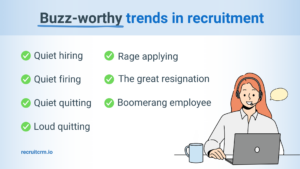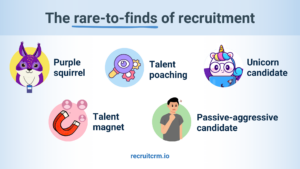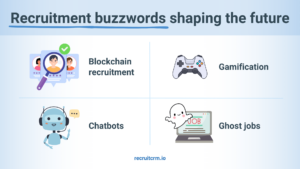Ever bumped into a recruiting term that left you puzzled? You’re not the only one.
Recruitment buzzwords are not just fancy jargon—they are trendsetters that are reshaping the industry lingo, making it broader and more comprehensive.
Keeping up with these terms is key to connecting with potential talent effectively.
Sounds like a task? Don’t worry!
To make things easier, we’ve neatly categorized the top jargon into 6 distinct sections.
This way, you can quickly add them to your recruiting dictionary without breaking a sweat.
Let’s get started!
I. Buzz-worthy trends in recruitment

1. Quiet hiring
Quiet hiring is a strategy where companies have to find the right person for important high-level positions (that too without creating a buzz in the industry).
This approach allows companies to take their time, assess potential candidates thoroughly, and make informed decisions without the pressure of prying eyes.
Here’s how you can effectively put quiet hiring into action:
- Tap into your existing networks and employee referrals to identify suitable candidates without the need for public job postings.
- If you must advertise, create confidential job listings that don’t reveal the company’s identity. Use generic JDs to keep things discreet.
- Reach out to potential talent individually, preferably through trusted channels or private platforms.
- Consider virtual platforms or neutral locations to avoid unnecessary speculation.
This approach not only preserves the company’s privacy but also allows for a deliberate and unhurried selection process, ensuring the best candidate for the role.
2. Quiet firing
Quiet firing is a tactic used by managers to subtly nudge employees out of the organization.
It aims to protect the company’s public image but often neglects the individual’s career growth and well-being.
Here’s how recruiters can navigate this delicate situation:
- This culture doesn’t always stem from a single symptom; it manifests through a combination of different actions. The signs that often indicate quiet firing of an employee:
-
- Tasks being reassigned to other employees.
- Assigning tasks that are beneath an employee’s job description or skill set.
- A lack of communication or regular check-ins.
- Employees rarely get proper feedback on their work.
- Limited opportunities for personal or professional skill development.
- Individual achievements and efforts are often overlooked.
- Encourage managers to initiate candid conversations with their team members.
- Ensure that employees have access to developmental opportunities such as career-related course certifications and other soft skills development programs.
- Advocate for the recognition of individual contributions, which can help in retaining talent and preventing quiet exits.
- Create channels where employees can voice their concerns and receive constructive feedback, promoting a culture of continuous improvement.
3. Quiet quitting
Quiet quitting is like a silent alarm that rings when an employee starts to pull away, their spark fading a little more each day, and it often goes unnoticed until it’s too late.
In the staffing industry, this is becoming a big deal.
Quiet quitting is not laziness but more of a self-preservation tactic to avoid burning out completely.
Tackling this issue means you’ve got to be on your toes with these tips:
- Using HR analytics to spot signs of unhappiness, like a spike in people leaving.
- Keeping a finger on the pulse of the company culture, checking out Glassdoor reviews, and having regular chats within teams.
- Building a place where everyone can talk openly and respect each other.
4. Loud quitting
Time to crank up the volume with loud quitting!
It’s a bold move where an employee makes a public exit, sometimes making waves across social media platforms.
This step is often a reflection of unresolved issues and unmet expectations within the organization.
Here’s how recruiters may tackle this:
- Encourage active listening to foster a culture where employees feel their voices are heard.
- Utilize exit interviews to uncover the underlying reasons behind such dramatic departures.
- Formulate strategies to respond to these incidents swiftly, mitigating probable reputational damage and showcasing a commitment to improvement.
5. Rage applying
Rage applying is more than just a spur-of-the-moment decision for any candidate.
It’s the result of mounting frustrations, often stemming from dissatisfaction with one’s current job or the challenges of finding a new one.
Here are some tips:
- Often, a negative experience at the current workplace, such as feeling undervalued or overlooked, can emotionally trigger this.
Some of the signs include:
-
- Hasty applications: Candidates apply to numerous positions in a short span, often without tailoring their resumes or cover letters.
- Mismatched roles: Applications often don’t align with the job seeker’s skill set or career goals, indicating a lack of thoughtful consideration.
- Emotional responses: Applicants might express heightened emotions or frustrations during the interview process.
- Offer supportive guidance: If you suspect a candidate is rage applying, take a moment to guide them by encouraging them to:
- Help them reassess their career aspirations and align their job search accordingly.
- Urge them to apply thoughtfully, considering the compatibility of the role with their skills and goals.
- Offer resources or workshops that help candidates navigate their job search more effectively, fostering a more thoughtful application process.
- Craft detailed job descriptions mentioning the skills and qualifications required for the job to deter rage applicants.
- Employ detailed application forms and rigorous pre-screenings to assess the genuine interest of applicants.
- Leverage AI recruiting software to detect patterns indicative of rage applying and streamline the talent acquisition process.
- Conduct comprehensive interviews: Delve deeper into an interviewee’s motives by asking about their interest in the role and their envisioned career trajectory.
6. The great resignation
Professionals are now rethinking what they want from their careers in a post-pandemic world, which makes ‘the great resignation’ more than just a passing trend.
Organizational psychologist Anthony Klotz coined the term in response to the waves of people voluntarily leaving their jobs in search of better opportunities.
They’re seeking roles that are more fulfilling, with a better work-life balance, and companies that genuinely care about their well-being.
Since December 2020, a staggering 25 million Americans have embarked on this journey, with more and more people joining the mass movement.
7. Boomerang employee
Picture someone you used to work with coming back to the team, but this time, they’ve got a bunch of new experiences and fresh perspectives to share.
Here’s why this trend is catching on:
- They come back as valuable assets with new skills and insights gained from other places.
- It is easy for them to get back on track due to their prior familiarity with the system and the team.
- Whether it’s better perks, a positive shift in company culture, or personal reasons, something good is drawing them back.
- Their comeback is like a vote of confidence in the direction the company is heading.
You might also like: High employee retention: Key to a successful organization
II. Dynamic working setups

1. Flextime
Flextime is like a breath of fresh air, allowing employees to mold their work hours within certain limits.
Imagine starting at 7 AM or 10 AM, suiting your productivity rhythm.
This system permits employees to accumulate extra working hours at a stretch, which can later be utilized for extended breaks or to facilitate a shorter workweek.
For instance, an employee might choose to work extra hours for four days to enjoy a three-day weekend.
The benefits? It helps reduce stress, keeps employees motivated, and boosts productivity.
2. Gig economy
Have you noticed the big shift from the old 9 to 5 routine to something more flexible?
Welcome to the gig economy.
It’s a work model where timely routines do not tie people down.
They have the freedom to choose projects that match their skills and interests while offering better compensation.
This shift is creating opportunities for a diverse workforce comprising freelancers, gig workers, contractual workers, and temporary employees.
But, while it’s offering flexibility, gig working also raises questions about financial stability and job security.
3. Side hustle
A side hustle is not just a means to earn extra income; it’s how individuals can develop personal skills, time management, and work on career progression.
These individuals often bring a diverse skill set and a fresh perspective to the table, making them valuable assets to any organization.
Recognizing the skills and values that a side hustler can bring can be a game-changer in your hiring strategy. Additionally, understanding how individuals generate passive income can offer insights into their entrepreneurial spirit and resourcefulness.
4. Holacracy
Imagine a workplace where power is distributed evenly, fostering a culture of autonomy and innovation.
That’s holacracy for you.
It is a management style that emphasizes collaboration and equality, transforming the decision-making process into a collective endeavor.
This approach encourages individuals to take initiatives without constantly seeking approval from higher-ups, promoting a sense of independence and responsibility.
Here’s how you can cultivate a holacratic culture in your team:
- Look for potential hires who are self-starters and can thrive in an environment where they have the freedom to make decisions.
- Develop training modules that nurture collaborative leadership skills, preparing individuals to contribute effectively in a holacratic environment.
- Create a workspace that encourages innovation by giving employees the freedom to explore and implement new ideas.
You might also like: 8 strategies to strengthen your recruiting skills according to experts
III. The rare-to-finds of recruitment

1. Purple squirrel
Finding a purple squirrel refers to locating a candidate who perfectly matches the job role in terms of qualifications, experience, and cultural fit.
You’re looking for that almost mythical job applicant who not only ticks all the boxes but also fits right into the culture of your organization.
Beware, this search can be a time-consuming task.
Here’s how you can approach this:
- Understand the expectations of these individuals and create a targeted action plan before you go hunting.
- Enhance your employer brand to attract these individuals by showcasing the company culture and establishing a strong online presence.
- Identify the skills that are crucial for the job rather than getting swayed by a long list of qualifications.
2. Unicorn candidate
Unicorn candidates are folks who stand head and shoulders above the typical job applicant, bringing a unique blend of skills and qualities to the table.
Securing one is like striking gold, setting the stage for innovation and growth within your company.
Here’s how to approach this:
- First, focus on identifying people who’ve led teams and made groundbreaking contributions in their respective fields.
- Next, craft a strategy to engage these candidates, highlighting the unique opportunities and growth prospects your organization offers.
- Be prepared to offer competitive packages that meet their lofty expectations, blending a great salary with perks and, of course, flextime!
- Craft personalized messages to connect with them, showing how their unique skill set is just what your team has been missing.
3. Talent poaching
Talent poaching is a high-stakes game where companies snatch top talents from their competitors, especially in industries where specific skills are in high demand.
Here’s a little roadmap for you to tread this sensitive path:
- Keep an eye out for folks who have those in-demand skills and experiences that everyone in your industry is after.
- It’s crucial to know the legal landscape here, including the nitty-gritty of non-compete clauses and other contracts.
- Stick to an ethical route throughout, making sure both you and the prospective hire are clear and respectful about any existing agreements.
- Maintain a friendly vibe with other industry players, even while you’re on the hunt for the best talent. You wouldn’t want to sour your relationship with fellow competitors.
- Whip up offers that spotlight the special perks your organization has up its sleeve, something to give you an edge over the rest of the industry.
4. Talent magnet
The superpowers of the corporate world are generally considered ‘talent magnets.’
These are the well-to-do established companies that attract the best in the business talent, not just with hefty paychecks but with a promise of growth and a vibrant work culture.
Here’s what makes them stand out:
- They have a stellar reputation in the industry, reflected through positive employee testimonials and reviews.
- Offer clear paths for career growth, personal progression and skill enhancement.
- A collaborative and innovative work environment that fosters positivity and inclusivity.
5. Passive-aggressive candidate
Lastly, you might come across a passive-aggressive candidate in your journey.
Spotting and managing these individuals can be a tightrope walk.
But you can do so by developing an eye to catch the subtle signs, be it non-verbal cues or a reluctance to voice opinions.
Also, implement regular feedback sessions where they can express their thoughts in a structured and non-confrontational manner.
You might also like: How to come up with the right interview feedback? + Free templates
IV. Diversity and inclusivity
1. Inclusive language
Inclusive language is not just a trend but a necessity in the modern workspace.
It’s about crafting a narrative where every individual sees themselves represented, fostering a culture of respect and acknowledgment.
Here’s how you can weave this into your recruiting strategy:
- Sculpting job postings that are devoid of gender-biased terms, focusing instead on the skills and qualifications necessary for the role.
- Rolling out training modules that foster an inclusive language culture, promoting respect and understanding across the board.
- Setting up channels for feedback on language use, allowing for a culture of continuous improvement and adaptation.
- Encouraging leaders to use inclusive language, setting a precedent for others to follow.
2. Affinity bias
Affinity bias is a subtle yet significant barrier that often creeps into the recruiting process.
A situation in which you favor applicants with similar backgrounds or experiences to your own, perhaps unknowingly.
Breaking free from this cycle can open doors to a rich and diverse talent pool.
Here’s your roadmap to mitigating its effects:
- Implement a structured interview format to ensure a fair and unbiased evaluation of all candidates.
- Go for blind recruitment practices to eliminate unconscious bias in the initial stages of the selection process.
- Incorporate applicant tracking systems and AI-enabled tools to streamline the screening process, thereby minimizing bias.
- Invest in training initiatives that enable your hiring team to recognize and counteract different forms of bias.
You might also like: 10+ diversity recruiting strategies you need to implement right away
V. Effective and innovative recruitment approaches
1. Candidate nurturing
Contrary to popular belief, candidate nurturing is not just about filling a position, it’s about fostering relationships that might lead to future collaborations.
Here’s how you can ace it:
- Maintain personalized communication with prospective talent, offering them insights and updates that resonate with their career aspirations.
- Engage candidates by sharing insightful articles, webinars, or workshops that cater to their interests and professional growth.
- Establish a two-way street where individuals can share their expectations and feedback, helping to refine the nurturing process further.
- Create platforms where prospective candidates can interact, share knowledge, and build a community shaping a sense of belonging and engagement.
2. Employer value proposition
Crafting a compelling EVP is akin to narrating a story – a story that resonates with prospective employees, promising them not just a job but a journey of growth and fulfillment.
Here’s what it entails:
- Highlight clear pathways for career growth, skill development, and continuous learning, making your organization a nurturing ground for talent.
- Illustrate the organization’s commitment to employee well-being and work-life balance, making it a sought-after place to work.
- Showcase a culture of innovation, collaboration, and mutual respect that offers a satisfying work environment and a positive candidate experience.
You might also like: Positive candidate experience & organizational culture
VI. Recruitment buzzwords shaping the future

1. Blockchain in recruitment
Blockchain is revolutionizing the talent acquisition sector while promising transparency and efficiency.
It promises a system where educational and professional credentials are verified with utmost accuracy, minimizing the chances of fraud and misinformation.
The introduction of smart contracts in recruitment can facilitate seamless contract negotiations with candidates.
By automating various aspects of the hiring process, blockchain helps reduce operational costs, making it more cost-effective and streamlined for recruiters.
2. Gamification
Do you remember a time when games were out of fashion? No?
Of course, you don’t!
Gamification is more than just a trend; it’s a strategic way of making the recruitment phase a more engaging experience.
The application of game principles and elements to nongame contexts, in this case recruitment, is known as game-design insertion or gamification.
It adds a splash of creativity and fun that keeps you hooked.
Here’s a deeper insight:
- Gamification allows for interactive assessments where applicants can showcase their skills in a real-world scenario.
- It helps in identifying the right talent by assessing their problem-solving abilities and technical skills in a more engaging manner.
- Incorporating this into their hiring procedure allows recruiters to gain deeper insights into candidates’ capabilities and personality traits.
- A powerful feature for building an innovative and employee-centric employer brand while attracting top talent in the process.
3. Chatbots
Chatbots are no longer confined to customer service.
They are making significant inroads into the talent acquisition sector.
Here’s how they are reshaping the initial stages of recruitment:
- AI bots offer 24/7 round-the-clock assistance, answering candidate queries promptly and efficiently. No query goes unanswered, day or night.
- Their automation capabilities enable them to handle tasks such as scheduling interviews, sharing company details, and even assisting with applications.
- The systems can analyze and understand candidate preferences and suggest jobs that match their profile.
4. Ghost jobs
Ghost jobs are essentially job postings that companies put out without an actual vacancy to fill.
They, in fact, play a significant role in hiring strategy.
Here’s a closer look at how they work and benefit recruiters:
- Ghost jobs help recruiters gauge market dynamics, gaining insights into potential candidate availability and the competitive landscape.
- They assist in creating a robust database, ensuring a candidate pool for future opportunities.
- If advertised, they’re typically posted on official websites or job boards with detailed descriptions. Promotion is minimal to maintain discretion.
- Based on responses, organizations can adjust job descriptions and offerings for future vacancies.
Frequently asked questions
1. How can I identify a potential ‘boomerang employee,’ and what strategies can be employed to re-hire one successfully?
Identifying a potential ‘boomerang employee’ can be through tracking their career growth and maintaining a positive relationship post their exit.
When recruiting them, create a ‘welcome back’ program that helps them blend in seamlessly.
Consider setting up mentorship initiatives to foster connections with new team members.
2. What is ‘moonlighting’ and how to recognize it?
Moonlighting is the act of holding a secondary job besides one’s primary employment.
It can sometimes result in conflicts of interest or decreased productivity.
The following are indicators of employee moonlighting:
- A sudden drop in the employee’s output or quality of work.
- Noticeable adjustments to their regular work schedule, often coming in late or leaving early.
- Instances where the secondary job interferes with the employee’s responsibilities at their primary job.
- Increased signs of fatigue or stress, possibly affecting their performance at work.




